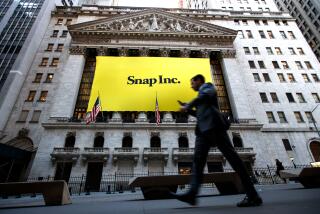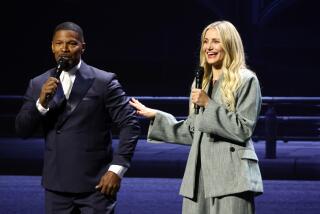Apps lead new wave in advertising
In the fast-changing world of mobile advertising, staples like banner ads, pop-ups and ads disguised as news stories aren’t cutting it anymore.
The latest crop of ads reads like novels, mimics the levels of a video game and lets Snoopy hitch a ride on selfies.
Advertisers hope those flashier formats will encourage people to interact with ads on the smartphones and tablets that are dominating their lives. Deeper engagement, they say, tends to make brand names stick in people’s minds, translating to higher spending.
Mobile advertising is growing fast, with sales expected to top $100 billion this year for the first time.
But the banner ads that advertisers relied on for two decades are now being vanquished by ad-blocking software or simply ignored. Native ads, which resemble news stories instead of sales pitches, are distrusted by consumers.
That’s created opportunity for Snapchat Inc., Zynga Inc. and other mobile app companies, which are experimenting with a new wave of ad options. They say consumers want more than a static message; they want ads to be fun and a utility — something they can use and share.
“It’s not just buying a Super Bowl ad and a big New York Times spread before Christmas,” said Adam Simon, director of strategy at ad firm IPG Media Lab. “There’s a lot more strategy and debate about what’s the right place to reach your consumers, with a focus on providing them some value.”
Venice-based Snapchat lets advertisers create their own Lenses, a type of animation launched in the fall that users select to alter their photos and videos. For instance, one popular Lens on Snapchat lets users overlay a cartoon rainbow on their faces, making it look as if they’re vomiting rainbows.
Sponsored Lenses allow advertisers to get in on the fun. Twentieth Century Fox and digital ad agency Avatar Labs recently designed Lens for “The Peanuts Movie” that allowed users to virtually chomp on a waterfall of candy corn while Snoopy danced in the foreground of their photos.
Tens of millions of people saw the animation or used it in posts shared with friends. Jason Steinberg of Avatar Labs said Snapchat’s users would remember who made the ad because they respond well to creative, usable content.
Meanwhile, Zynga’s value-laden ads involve what it does best: making games. Advertisers get sponsored levels that sit within games and can affect their results.
One ad, by salad dressing brand Hidden Valley, invited players of Zynga’s matching game “Farmville: Harvest Swap” to earn a ranch chicken pizza recipe by matching ingredients, including bottles of Hidden Valley ranch. The brand wanted people to consider using ranch on more than salads, and the game experience conveyed that idea to up to about 1.5 million people.
Players spent an average of 25 seconds in branded levels in early campaigns, said Julie Shumaker, general manager of Zynga’s in-house advertising unit, StudioE. And purchase desire for pitched products at least doubled on average.
The tactic was notable because mobile games often bribe users with virtual currency to get them to watch video ads. But Zynga wanted users to earn rewards through play. Zynga also can show a lot more of sponsored play ads and charge more for them because they aren’t as interruptive as videos.
Smaller companies have twists on online ads too.
Wattpad’s 40 million users submit and read fiction on the app, so the company decided ads should also be stories. They grip people’s undivided attention, the company reasoned.
General Electric Co.’s ad-stories on Wattpad were written by top science fiction writers on the service. Instead of pitching GE refrigerators or washer-dryers, the resulting stories chronicled the exploits of young technologists. The stories, carried on GE’s account, were labeled “Sponsored” and garnered 40,000 views, Wattpad said.
“It’s becoming harder and harder to find audiences through traditional advertising,” said Sam Olstein, GE’s global director of innovation. “We just want to find new audiences in unconventional ways.”
Music streaming app start-up Dash Radio has 3 million users. Instead of intrusive ads that play in between songs, advertisers on the streaming platform — including video game “Halo” and the movie “Entourage” — sponsor their own playlists filled with interviews or songs from their soundtracks. Dash said users listen to sponsored playlists for an average of 25 minutes.
The increasingly fancier mobile ads pose a threat to websites, newspapers, radio stations and cable television — all of which could see revenue sucked away because their business models depend on the old-school formats. Across the digital landscape, companies are rushing to adapt.
Santa Monica-based Demand Media dramatically reduced the number of ads on EHow.com, Cracked.com and other popular websites, aiming to supplant them with sponsored podcasts, and other deeper ad integrations. Woven Digital, the Culver City company behind brands such as BroBible and Uproxx, is heavily investing in creating conversation-stimulating video series that advertisers can sponsor.
Still, cheap online ads are a huge business. As they continue to overtake expensive TV buys, worldwide ad budgets are expected to grow slowly to $526 billion in 2016 from $503 billion in 2015, according to research firm Magna Global.
Ad executives caution that new technology could quash the promising early endeavors long before they endure as long as banner ads have.
Trying “a bunch of tactics to track down a moving target is going to be a reality for a long time,” said Avatar Labs’ Steinberg.
Twitter: @peard33







